List of mango cultivars
Worldwide, hundreds of mango cultivars exist. In mango orchards, multiple cultivars are often grown together to improve cross-pollination.

Table of mangoes
Reportedly, in India alone, there are around 283 types of mangoes, out of which only 30 are well-known.[1][2] The United States Department of Agriculture (USDA) facility on Old Cutler Road in Coral Gables, Florida, has about 400 varieties of mangoes and is one of the largest depositories of mango plant cultures in the world. The USDA collection was originally believed to have over 500 varieties of mango germplasm, but genetic testing showed several duplicates. In the United States, South Florida is one of the meccas for mangoes due to year-round temperate climate and culture fascinated by mangoes and several nurseries dedicated to bringing new varieties of mangoes into the US by either import or selective breeding. Reviews of older varieties of mangoes were based upon the competition available at the time. Most of the varieties of mangoes available in grocery stores in the United States trace their lineage to the Haden mango tree, a tree planted by Jack Haden in 1902 in Coral Gables, Florida. The Zills family has created a number of new varieties of mango, most recently, Gary Zill with Zill's High Performance a selective breeding program of new varieties. The following are among the more widely grown mango cultivars, listed by the country in which they were selected or are most extensively cultivated:
| Common name(s) |
Image | Origin/ region |
Notes |
|---|---|---|---|
| Alampur Baneshan | 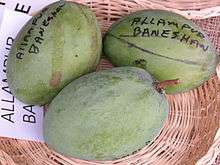 |
India, United States | |
| Alice |  |
United States | |
| Almaas | Pakistan | ||
| Alphonso |  |
India, Pakistan, Ecuador, Egypt, Sudan, United States, Nepal | "King of mangoes", very sweet with fibreless pulp, rich in vitamin A and C, founded mainly in Devgad & Ratnagiri Districts of Maharashtra, India. This cultivar is available in February till end of May. The dates of availability of mangoes varies by geography, climate, and weather. The "King of Mangoes" is a marketing term. |
| Amrapali | India | ||
| Anderson | 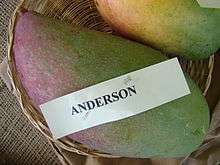 |
United States | Anderson is a seddlings of Sandersha that was planted at teh residence of Mrs. L.F. Anderson in Miami, Florida. Anderson is a large mango, growing in length from 26–34 cm. [Mangoes: A Guide To Mangoes In Florida, p. 30] The eating quality was listed as "fair." |
| Angie |  |
Florida, United States | Angie mango is a dwarfing mango tree from Florida with excellent eating quality. Angie has a resinous taste, similar to the Carrie mango. Angie is considered disease-resistant, but in high humidity environments, Angie's new leaf growth is susceptible to mango scab. |
| Anwar Ratol | Multan, Punjab (Pakistan) | Small in size and flesh without fibre . Peak season is mid-July to August. | |
| Ataulfo |  |
Ecuador, Mexico | |
| Badami | Karnataka, India | Badami mangoes are also called as Alphonso of Karnataka state. | |
| Bailey's Marvel | 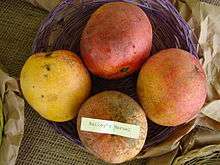 |
United States | |
| Banganapalli |  |
India | The largest volume mango cultivar in the world, this medium-large fruit ripens to a golden-yellow exterior and a straw-yellow to golden-yellow interior. Very juicy, slightly tangy with little or no fibre and a creamy texture. It originates from the erstwhile princely state of Banganapalle, in present-day Andhra Pradesh, India. |
| Bangalora | India | It is also known as Kilimooku mangoes | |
| Bennet Alphonso |  |
United States | |
| Beverly | |
United States | Beverly is an almost fiber-less late season mango. In South Florida, fruiting as late as August or October. |
| Black and Rose | |
India Kerala | Black and Rose [3] |
| Bombay |  |
India, Nepal, United States | Bombay is a vigorous mango tree that bears fruit in June–July in South Florida. It is susceptible to anthracnose. Bombay is the parent of the White Perie mango of Hawaii. |
| Brahm Kai Meu |  |
United States | |
| Brooks | 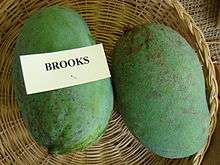 |
Australia, United States | |
| Carabao (Philippine Mango) |  |
Philippines | The Ataulfo (mango) and Manilita mango cultivars originated from the Philippine Mango variety. It can be traced back in the Manila-Mexico galleon trade in the years 1600-1800's.[4] |
| Carrie |  |
United States | Carrie is a seedling of a Sophie Fry from the residence of Mr. Lawrence H. Zill of Boynton Beach, Florida. It was named in honor of Mr. Zill's mother, Carrie. The Carrie mango has turns slight yellow when ripe, but what it lacks in color, it makes up in taste. The Carrie mango has a strong resinous flavor that his desired by some, and despised by others. A Carrie mango must be allowed to ripen on the tree and develops a strong "musky" flavor when over-ripe. |
| Chaunsa | |
India, Sindh, Pakistan | |
| Chinnarasamu | Nuzvid in Andhra Pradesh of India | ||
| Cherukurasamu | Nuzvid in Andhra Pradesh of India | ||
| Coconut Cream | [] | United States | Coconut Cream is part of the selective breeding program by Zills High Performance and is patented. The fruit tastes like coconut cream pie. The tree is ugly in appearance because the branches grow in arcs and curve around, making a complex tree canopy. |
| Chok anan |  |
Pakistan, Bangladesh, India, Thailand | Choc anon is known as the every bearing mango tree because of its potential to have a mango crop during the summer and winter. Some speculate that removing the summer crop may increase the chances of a winter crop by allowing the tree to save the energy that would have been used for fruit production in the summer. |
| Cogshall |  |
United States | Cogshall is from Pine Island, Florida. It is an excellent eating quality, but is not commercially available because of very short shelf-life and thin skin that would bruise easily. |
| Cushman |  |
United States | |
| Dasheri | |
India, Nepal, Pakistan, | stories about its origin but the owners say it is a "chance" seedling. |
| Dot | 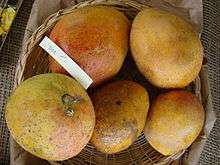 |
United States | Dot is an exceptional tasting mango. Dot is a seedling of the Carrie Mango planted at Lawrence Zill's Boynton Beach, Florida home. The dot mango is highly susceptible to anthracnose, so it should not be planted in high humidity locations. |
| Dudhiya Malda | India, Nepal | Grown in Digha, Patna, Bihar. Known for awesome taste and flavour with thin skin[5][6][7][8] | |
| Duncan |  |
United States | Duncan mango was patented by David Sturrock of West Palm Beach, Florida. The patent has long since expired. Duncan fruits in clusters and has excellent disease resistance. It is a mid-late season mango. |
| Earlygold | |
United States | |
| Edward | 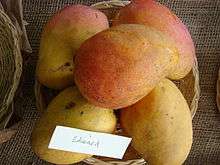 |
United States | Edward is an excellent eating quality mango, but is considered to be a shy bearer (little fruit). |
| Eldon |  |
United States | |
| Emerald | United States | ||
| Fazli (mango) | Bangladesh, India | ||
| Fajri Kalan | Pakistan | ||
| Fairchild |  |
United States | |
| Fascell |  |
United States | |
| Florigon |  |
United States | Florigon is a settling of a Saigon planted on the property of Mr. John C. Kaiser, Fort Lauderdale, Florida. The tree is vigorous. Florigon is considered to be one of the most disease resistant varieties of mangoes in high humid climates, although the flavor is not on par with many of the newer varieties. |
| Ford | 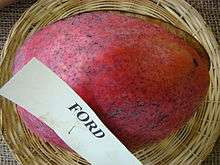 |
United States | |
| Gary | |
United States | The Gary mango is considered delicious by many with a hint of coconut flavor. Gary is considered very susceptible to anthracnose. |
| Gir Kesar | Gujarat (India) | ||
| Glenn |  |
Italy, United States | Glenn is a sweet, mild mango. The tree is vigorous, to a medium size. Canopy is rounded. The ripe fruit has a very pleasant sweet smell. |
| Gold Nugget |  |
United States | |
| Golden Lippens | United States | ||
| Graham |  |
United States | Graham is from Trinidad. Compared with many modern mangoes, Graham seems bland. |
| Green Willard | Sri Lanka | ||
| Haden |  |
Australia, Brazil, Costa Rica, Ecuador, Guatemala, Honduras, Mexico, United States | Haden is the "parent" of many, many other varieties of mangoes in the United States. Haden was a Mulgoba seedling. The original Haden tree still stands in Coral Gables, Florida. |
| Hatcher | United States | ||
| Heidi | South Africa | ||
| Himayat / Imam Pasand |  |
India | |
| Himsagar |  |
Bangladesh, India, Nepal | |
| Ice Cream | United States | ||
| Irwin | 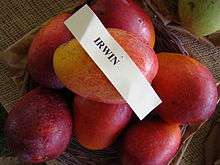 |
Australia, Costa Rica, United States, Taiwan, Japan (Okinawa) | In Japan this variety is marketed as Apple Mango, and in the case of imports from Japan one needs to take care not to confuse it with the Apple Mango grown in the Philippines. |
| Ivory |
|
China | Also known as the Jingu Ivory mango, or Ivory mango, this long, thin mango is named for its resemblance to a young elephant's tusk. It has thin skin, smooth skin. The flesh contains very few fibres, and constitutes approximately 82 percent of the fruit. It was first introduced into Yunnan, China from Thailand in 1914. The actual tree that was the first to be imported still grows, and during one year produced almost 500 kg of fruit.[9] |
| Jakarta |  |
United States | |
| Jean Ellen | |
United States | |
| Julie | Ecuador, United States | A colourful, potato shaped mango with a sweet-tart flavour and a tall growth habit. Very popular in the Caribbean Sea, including Jamaica the British Virgin Islands, the United States Virgin Islands, and Barbados. Julie is a high fiber mango. | |
| Kalepad | Andhra Pradesh, India | ||
| Keitt |  |
Australia, Costa Rica, Ecuador, Italy, South Africa, United States | Keitt (pronounced "kit") is one of the latest season mangoes in South Florida (United States), with fruit into October. Backyard Keitt's in South Florida regularly get to 2 pounds, and occasionally as large as 5 pounds. |
| Kensington Pride |  |
Australia, Italy, United States | |
| Kent |  |
Australia, Ecuador, Guatemala, Honduras, Israel, Italy, Mexico, South Africa, United States | The original Kent tree still stands in Coral Gables, Florida (United States) |
| Kohu Amba | Sri Lanka | ||
| Kothapalli Kobbari | Pithapuram, Andhra Pradesh of India | Also known as Kobbari Mamidi. | |
| Lakshmanbhog | India | ||
| Lancetilla |  |
Honduras, United States | Lancetilla can bear 5 pound fruit, but the eating quality is considered sub-part among mango connoisseurs. The fruit is prone to splitting on the tree. |
| Langra | |
India, Pakistan, Bangladesh, | |
| Lippens |  |
United States | |
| Madame Francis | Haiti | Large kidney shaped mango that ripens to a golden yellow colour with piquant flesh Commonly exported to the United States in spring; often a feature of NYC fruit stands. Madame Francis is a high fiber mango. | |
| Mahachanok | [] | Asia, United States | Mahachanok is an oblong commercial mango from Asia, with yellow to orange color exterior when ripe. Described a fiberless, sweet, and pleasant mango. The leaves of the tree are dark green and slimmer than many other mango trees. |
| Mallika |  |
India, Nepal, United States | |
| Malwana (mango) | Sri Lanka | ||
| Manilita | United States | ||
| Manohar | Punjab, India | Large mango grows in clusters, seedling of Chaunsa. Exceptional complex flavor good sweetness. Very vigorous. | |
| Momi K[10] | Hawaii, United States | Teardrop shaped with a narrow point. Ripens to a reddish orange blush. Flesh has creamy consistency. | |
| Muhammad Wala | Pakistan | ||
| Mulgoba |  |
India, United States | Small mango with a comparatively big seed. Parent of the Haden mango. |
| Nam Doc Mai | Thailand | Fruit is elongated, with a prominent beak, and is normally yellow with green spots. | |
| Neelam | India, Pakistan | Fruit weigh 9 to 12 oz, with the general shape of a fat cashew nut. They are smooth-skinned and bright yellow upon ripening and have no blush. The flesh is deep yellow or orange. There is no fiber and a rich, aromatic flavor that is over-powering to the unaccustomed palate. They have a late ripening season and can be stored for an extended time. Fruit should be harvested when mature green and ripened at room temperature off the tree. | |
| Osteen |  |
Italy, Spain, United States | |
| Palmer | 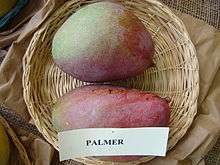 |
Australia, Brazil, United States | |
| Panakalu | Andhra Pradesh of India | ||
| Panchadharakalasa | Andhra Pradesh of India | ||
| Parvin | |
United States | |
| Pina Colada | [] | United States | Pina Colada is part of the selective breeding program by Zills High Performance. Pine Colada is a small fruit that packs a lot of flavor. The tree is unproductive and susceptible to anthracnose. |
| Peddarasamu | Nuzvid in Andhra Pradesh of India | ||
| Raspuri |  |
Karnataka, India | An extremely popular variety in South India, a fully ripe Raspuri mango harvested at the right time and ripened naturally can beat them all, including the Alphonso, in taste as well as amount of juice per mango. Many people especially Kannadigas do not even ask for any another variety except Raspuri in Bengaluru. |
| Red Willard | Sri Lanka | ||
| Rosigold | |
United States | Rosigold is considered one of the earliest season mangos in South Florida. The quality is considered average, but at a time of year when there are no fresh mangoes it is in its own class. Rosigold is susceptible to anthracnose. |
| Ruby | 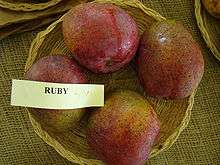 |
United States | |
| Saigon | 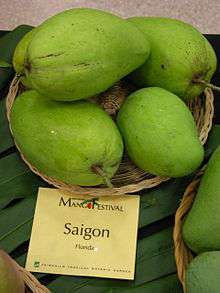 |
United States | |
| Sindhri | |
Sindh Pakistan | Sindhi Mango cultivated in Sindhri town Mirpur Khas district, Sindh province of Pakistan |
| San Felipe | Cuba | Fruit is large at 20 ounces with a striking oxblood color; the flesh is yellow. | |
| Saharni | Pakistan | ||
| Sammar Bahisht | Pakistan, India | (in Urdu Sammar means fruit and Bahisht means Paradise) | |
| Sensation |  |
South Africa, United States | |
| Shan-e-Khuda |  |
Pakistan | |
| Sindhri | |
Mirpur Khas district, Sindh province of Pakistan | Sindhi mango cultivated in Sindhri town Mirpur Khas district, Sindh province of Pakistan |
| Sophie Fry |  |
United States | |
| Southern Blush | United States | ||
| Spirit of '76 | United States | Spirit of 76 is a seedling from Lawrence Zill's residence. The mango is fiberless and has a very pleasant sweet flavor. | |
| Springfels |  |
United States | One of the older cultivars from Florida, but still good tasting. It is a large mango, but Due to its size, it has uneven ripening. The uneven ripening is known as "jelly seed," where the flesh around the seed is overripe and soft. |
| Sunset |  |
United States | |
| Swarnarekha | Andhra Pradesh of India | ||
| Tommy Atkins |  |
Brazil, Costa Rica, Ecuador, Guatemala, Honduras, Israel, Italy, Mexico, South Africa, United States, Venezuela | One of the most commonly sold mangoes in the world. has extremely long shelf life. Hard and oblong exterior. It is a pretty mango, but not as good tasting as many other top tier modern mangoes. |
| Torbert | United States | ||
| Totapuri |  |
India | |
| Turpentine | United States | Turpentine is a small, high fiber mango that is poly embryonic mango. Turpentine is used as a rootstock in Florida for grafting other mango varieties. | |
| Valencia Pride |  |
South Africa, United States | Large, oblong mango. Sweet, mild flavor, but the fruit is prone to splitting on the tree. The tree is a vigorous grower. |
| Van Dyke |  |
Italy, United States | |
| Vellai Kolomban | Sri Lanka | ||
| Young | United States | Young mango was renamed as the "Tebow" (after the American football player) for marketing purposes. | |
| Zill | 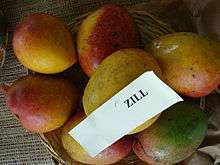 |
South Africa, United States | Zill is a seedling of Haden planted in 1922 by Carl King of Lake Worth, Florida (US). Vigorous tree, fruit is good eating quality. |
List of cultivars by nation
Asia
- Bangladesh: Chok anan, Ashini, Fazli, Himsagar, Khirshapat, Langra, Lokhon-bhog, Raj-bhog
- Cambodia: Cambodiana
- China: Baiyu, Guixiang, Huangpi, Huangyu, Macheco, Sannian, Yuexi
- India: Alphonso,[11] Amrapali, Alampur Baneshan, Badshahpasand, Bangalora, Banganapalli,[11] Black and Rose,[3] Bombay, Bombay Green, Badami, Cheruku Rasalu, Chinna Rasalu, Chok anan, Thalimango, Chitoor, Rumani, Maharaja Pasand, Chinnarasam, Unda manfa, Dusehri, Ela Manga, Gaddamar, Gadam Mary, Fajri Kalan, Fernandian, Fajli, HusanNara, Gulabkhas, Himayath, Himsagar, Imam Pasand,[11] Imam Hussain Mango, Jehangir, Ottu Mangai, Langra Benarsi, Pedda Rasalu, Surkha, Totapuri, Kalepad, Kishen Bhog, Komanga, Kothapalli Kobbari, Kuttiyattor, Kalami, Kesar, Lalbaug, Langra, Maldah, Malgis, Mallika, Malgoa,[11] Mankur (Goa), Mankurad, Moovandan, Nagulapalli Rasalu, Nattuma, Nannari, Neelum, Neeleshan, Panchadara Kalasa, Puliyan, Panduri Mamidi, Payri, Priyor, Rani, Rajapuri, Raspuri, Ratna, Rayal Special, Sindhooram, Safeda, Sammar Bahisht, Suvarnarekha, Totapuri Vanraj, Yahya Mariam Mango, Zardalu.
- Indonesia: Arumanis/Harumanis, Gadung/Gedong, Manalagi, Cengkir/Indramayu, Gajah, Bapang, Lalijiwo, Kueni, Golek, Kemiri, Boled, Bengkulu, Situbondo, Kelapa, Alor, Selaputih
- Japan (Okinawa): Irwin
- Malaysia: Apple Mango, Apple Rumani, Arumanis, Golek, Kuala Selangor, Malgoa, Maha-65, Tok Boon
- Myanmar: Aug Din ( ျမေက်ာက္), Ma Chit Su (မချစ်စု), Sein Ta Lone (စိန်တလုံး), Shwe Hin Tha (ရွှေဟင်္သာ)
- Nepal: Amrapali, Dusehri, Bombay, Mallika, Pharsi aamp, Supadi aamp, Sindure aamp and other local cultivars.
- Pakistan: Almaas, Alphonso, Anmol, Anwar Rataul, BaganPali, Chaunsa, Chok anan, Collector, Dusehri, Desi Ada Pamato, Desi Badam, Desi Gola, Desi Badshah, Dilkash, Fajri, Gulab Janhu, Gulab Khas, Lahoti, Lal Badshah, Langra, Maldah, Muhammad Wole, Nawab Puri, Neelum, Rani Phool, Sindhri, Saroli, Sawarnarika, Saleh Bhai, Saib, Shan-e-Khuda, Taimuria, Toofan, Wanghi, Zafran
- Philippines: Apple Mango, Carabao or Kinalabaw, Indian, Piko, Paho, Pahohutan
- Singapore: Apple Mango, Arumanis, Golek, Kaem Yao, Mangga Dadol
- Sri Lanka: Dampara, Hingurakgoda, Karutha Kolomban, Malwana[under-ground] amba, Parrot Mango and Peterpasand, Petti amba, Rata amba, Vellai Kolomban, Wild Mango, Willard, Mee Amba, Kohu Amba, Pol Amba, Giraa amba, Red Willard, Green Willard, Mallika, TJC Mango.
- Taiwan: JinHwang, Red JinHwang, Tainong No.1, Irwin
- Thailand: Chok anan, Khaew Sawei, Nam Doc Mai, Rad, Brahm Kai Meu, Okrong
- Vietnam: Cao Lãnh Cát Chu mango, Bình Định Elephant mango, Hoà Lộc Sand mango
- West Indies: Amélie, Black (blackie), Bombay, Dou-douce, East Indian, Graham, Haden, Julie (St. Julian), Long, Madame Francis, Rose, Spice-Box, Starch
Oceania
- Australia:[12] B74 (known by the brand name Calypso), Brooks, Green eating, Haden, Irwin, Keitt, Kensington Pride, Kent, Nam Doc Mai, Palmer, R2E2, Honey Gold.
- Hawaii: Hawaiian Common, Gouveia, Hawaiian Dwarf, Kurahige, Mapulehu, Momi K, Pope, Rapoza, Sugai, Turpentine
Africa
- Cameroon: Améliorée du Cameroun
- Egypt: Alphonso, Hindi, Hindi Besennara, Beid El Agl, Oweisi, Fuss Oweis, Taymoor, Zebdiah, Mesk
- Kenya: Apple Mango,[13] Batwi, Boubo, Ngowe

- Mali: Amelie, Kent
- Réunion island: Carotte, Jose, Lucie, Auguste
- South Africa: Fascell, Haden, Keitt, Kent, Sensation, Tommy Atkins, Zill
- Sudan: Alfonso, Bez el-Anza, Oweisi, Taymoor
- Suriname: Rood borsje, Tetéé
- Tanzania: Boribo Muyini, Dodo, Mawazo, Sindano
- Zambia: Heidi, Kent, Sensation, Tommy
Americas
- Brazil: Coquinho, Haden, Manga Espada, Manga Rosa, Palmer, Tommy Atkins
- Costa Rica: Haden, Irwin, Keitt, Mora, Tommy Atkins
- Cuba: San Felipe, Prieto, Toledo
- Ecuador: Ambassador, Alphonso, Ataulfo, Criollos, Haden, Julie, Keitt, Kent, Reina, Tommy Atkins
- Guatemala: Haden, Kent, Tommy Atkins
- Haiti: Francine (Madame Francis), Muscas, Labiche, Baptiste, Rosalie, Poirier, Corne, Fil
- Honduras: Haden, Kent, Lancetilla, Tommy Atkins
- Mexico: Ataulfo, Haden, Irwin, Kent, Manila, Palmer, Sensation, Tommy Atkins, Van Dyke, Petakon, Oro, Criollo, Niño, Miyako.
- Peru: Criollos, Haden, Keitt, Kent, Tommy Atkins
- US (California): Keitt, Haden, Timotayo, Manila
- US (Florida): Alampur Baneshan, Alice, Alphonso, Anderson, Angie, Bailey's Marvel, Bennet Alphonso, Beverly, Bombay, Brahm Kai Meu, Brooks, Carabao, Carrie, Chok Anon, Cogshall, Cushman, Dot, Duncan, Earlygold, East Indian, Edward, Eldon, Emerald, Fairchild, Fascell, Florigon, Ford, Gary, Gaylour, Glenn, Gold Nugget, Golden Lippens, Graham, Haden, Hatcher, Ice Cream, Irwin, Ivory, Jakarta, Jean Ellen, Julie, Keitt, Kensington Pride, Kent, Lancetilla, Langra Benarsi, Lippens, Mallika, Manilita, Mendoza, Mulgoba, Nam Doc Mai, Nam Tam Teen, Neelum, Nu Wun Chan, Okrung, Osteen, Palmer, Parvin, Pascual, Philippine, Pickering, Po Pyu Kalay, Rosigold, Ruby, Rutledge, Saigon, Sensation, Sophie Fry, Southern Blush, Spirit of '76, Springfels, Sunset, Suwon Tip, Tebow, Toledo, Tom Dang, Tommy Atkins, Torbert, Turpentine, Valencia Pride, Van Dyke, Zill
- Venezuela: Haden, Keitt, Kent, Tommy Atkins
Europe
- Italy: Kensington Pride, Glenn, Tommy Atkins, Keitt, Maya, Van Dyke, Osteen, Kent[14]
Middle East
- Israel: Haden, Omer, Shelley, Keitt, Kent, Maya, Nimrod, Palmer, Tommy Atkins, BD-4-98
See also
- International Code of Nomenclature for Cultivated Plants
- Photos of different mango cultivars from wikimedia
References
- ↑ "Treat yourself to mangoes on Jayamahal Road".
- ↑ "Top 10 Different Types Of Mangoes Grown In India".
- 1 2 Mango variety Kerala Black and Rose
- ↑ "Manila Super Mango (Philippine Mango), the world's sweetest mango.". Retrieved May 7, 2015.
- ↑ "Digha Ghat's Dudhiya Malda considered 'King of Mangoes' in Bihar". dna. 2015-05-26. Retrieved 2016-06-20.
- ↑ "All that you wanted to know about mangoes". The Telegraph. Retrieved 2016-06-20.
- ↑ "Dudhiya Malda – FoodsOnStreet". foodsonstreet.wordpress.com. Retrieved 2016-06-20.
- ↑ "Agriculture Market News Information from APEDA AgriExchange". agriexchange.apeda.gov.in. Retrieved 2016-06-20.
- ↑ "Jinggu "Ivory" Mango-Yunnan Tourism Website". En.ynta.gov.cn. Retrieved 2014-03-21.
- ↑ http://www.extento.hawaii.edu/kbase/crop/crops/i_mango.htm
- 1 2 3 4 "Mango varieties". The Hindu. p. 15. Retrieved 2016-04-13.
- ↑ "Australian Mangoes - Australian Varieties". Mangoes.net.au. Retrieved 2014-03-21.
- ↑ "Mukuyu farm, 20ha of commercial land in Ukambani| Kibwezi river". Better Globe Forestry. Retrieved 2014-03-21.
- ↑ http://www.freshplaza.it/images/2010/1220/coltivazione_del_mango_in_Sicilia.pdf
External links
| Wikimedia Commons has media related to List of mango cultivars. |